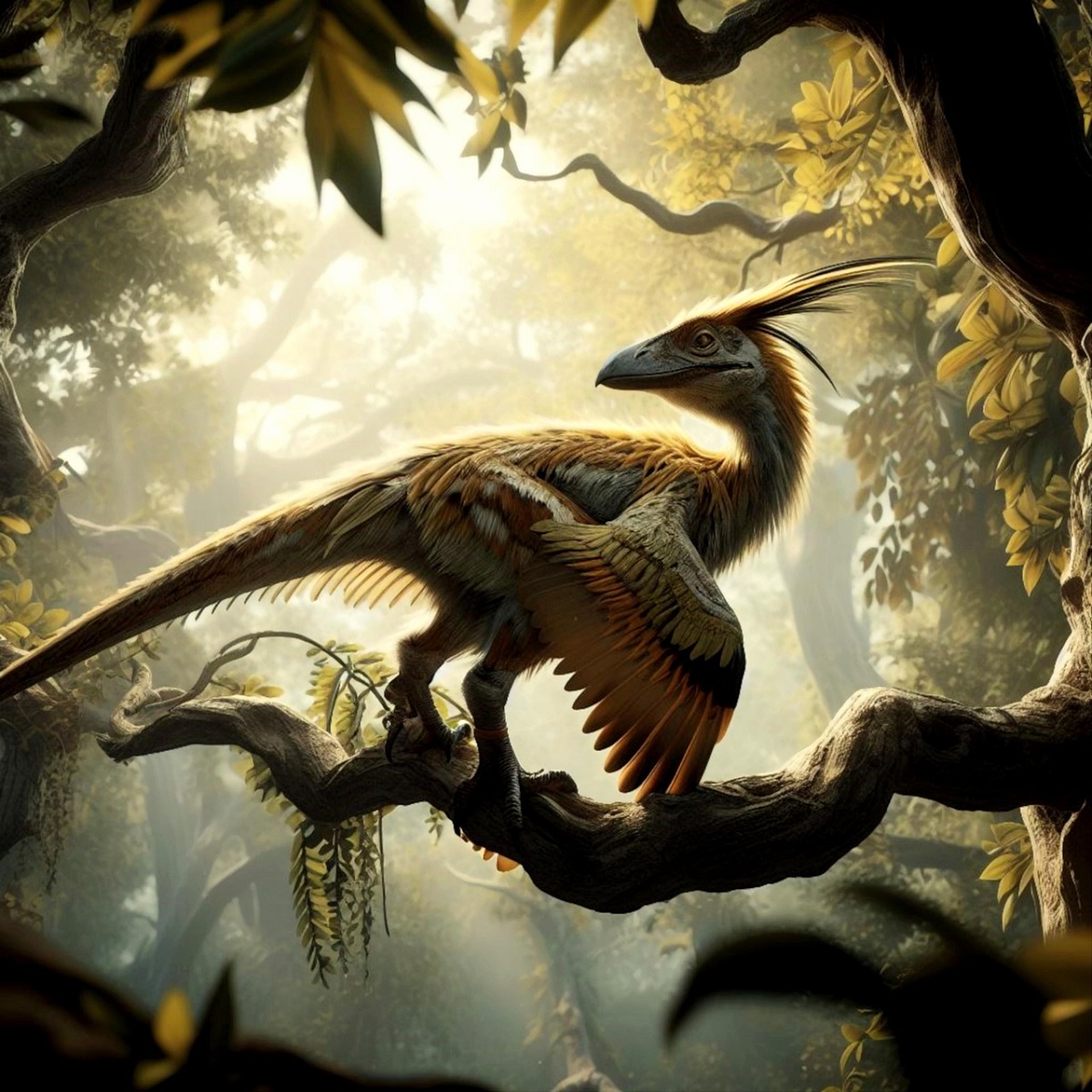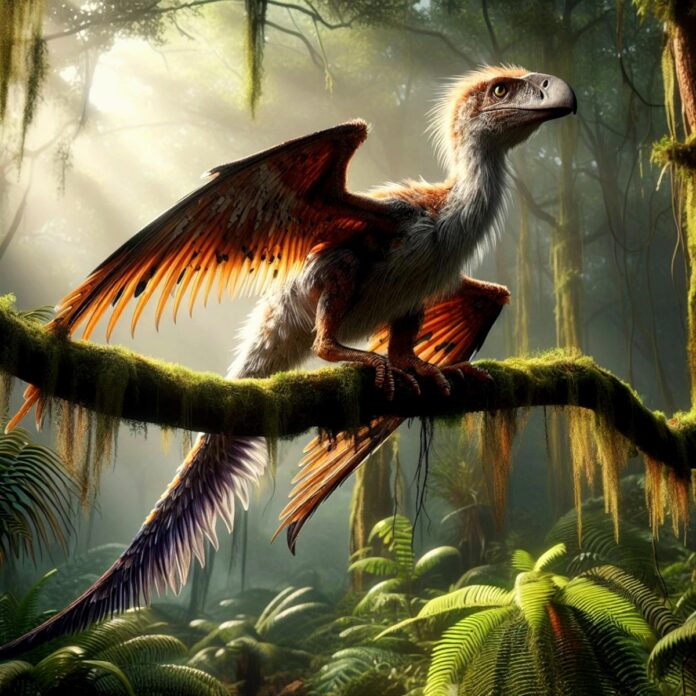Summary: Archaeopteryx is a pivotal prehistoric fossil often considered the earliest known bird, dating from the Late Jurassic period about 150 million years ago. Exhibiting both reptilian (teeth, long bony tail, clawed fingers) and avian (feathered wings, wishbone) traits, Archaeopteryx provides crucial insight into the evolutionary link between dinosaurs and modern birds. Found primarily in Germany's Solnhofen limestone, its discovery reshaped our understanding of evolution and flight origins.
Few fossils have ignited as much excitement, scientific curiosity, and philosophical reflection as Archaeopteryx. Often hailed as the first true bird, this feathered creature lived during the Late Jurassic Period, approximately 150 million years ago, at a time when the Earth was ruled by colossal dinosaurs and dense tropical forests sprawled across the continents. The discovery of Archaeopteryx not only astonished the 19th-century scientific community but also served as a powerful confirmation of Charles Darwin’s then-revolutionary theory of evolution by natural selection. As one of the earliest known transitional fossils, Archaeopteryx bridges the evolutionary gap between non-avian dinosaurs and modern birds, illustrating in physical form how significant anatomical changes can occur over millennia.
In this article, we delve into the fascinating world of Archaeopteryx, exploring its discovery, biology, ecological significance, flight capabilities, and the role it plays in our understanding of evolutionary history. With a focus on SEO-rich content and detailed insights, we aim to comprehensively explore this ancient marvel that continues to inspire researchers and laypeople alike.
The Discovery of Archaeopteryx: A Landmark in Paleontology

The first Archaeopteryx specimen was unearthed in 1861 in the Solnhofen limestone quarries in Bavaria, Germany, a region renowned for its fine-grained limestone that preserved organisms with remarkable detail. At the time, the scientific world was still grappling with the implications of Darwin’s On the Origin of Species, published just two years earlier in 1859. The discovery of a fossil that combined avian feathers with a reptilian skeleton stunned the scientific community. It perfectly embodied evolutionary theory, showing a direct link between reptiles and birds.
The initial fossil, known as the London specimen, consisted of a single feather—delicately preserved and unmistakably avian. Later in the same year, a more complete specimen was found and sold to the Natural History Museum in London. Since then, 12 notable Archaeopteryx fossils have been discovered, including the Berlin specimen, which remains the most complete and best preserved. Each new find has offered fresh insight into the anatomy and evolutionary position of this remarkable creature, fueling debates and sparking new lines of scientific inquiry.
Physical Characteristics
Archaeopteryx was a small, lightweight animal roughly the size of a modern-day magpie or raven. It measured about 50 centimeters (20 inches) in length and weighed between 0.8 to 1 kilogram (1.8 to 2.2 pounds). Despite its modest dimensions, its anatomical features are anything but ordinary. Archaeopteryx displayed a unique combination of characteristics seen in both theropod dinosaurs and modern birds, making it a quintessential example of a mosaic organism.
On the avian side, it possessed well-developed feathers, including flight feathers with asymmetrical vanes that are nearly identical to those of modern birds. These feathers were located not only on its wings but also along its tail and legs. Its body structure included a wishbone (furcula), a feature crucial for the flight mechanics of birds, and a relatively light, pneumatized (hollow) skeleton that reduced body weight—another adaptation seen in modern avians.
In stark contrast to birds, Archaeopteryx had distinctly reptilian traits. Its skull featured sharp teeth embedded in sockets, unlike the toothless beaks of modern birds. It had three clawed fingers on each wing, which could grasp branches or prey, and a long, bony tail composed of over 20 vertebrae—features commonly associated with small theropod dinosaurs like Velociraptor and Deinonychus. It also lacked a keeled sternum, which in modern birds serves as the anchor point for powerful flight muscles. These anatomical features make it clear that Archaeopteryx was neither fully bird nor fully dinosaur, but a crucial evolutionary intermediary.
Feathered Evolution
The feathers of Archaeopteryx are among its most discussed features and are pivotal to our understanding of feather evolution. High-resolution fossil imaging has shown that these feathers were structurally advanced, with asymmetry and central shafts, much like those of today’s birds. This has led to extensive debate about whether Archaeopteryx was capable of powered flight, or if it merely used its feathers for gliding, thermal regulation, camouflage, or courtship displays.
One of the most significant revelations came in 2011, when researchers using synchrotron radiation X-ray imaging discovered melanosomes—the pigment-containing structures within the feathers. This allowed scientists to hypothesize that Archaeopteryx’s feathers may have been black, possibly improving aerodynamic performance and feather strength. More importantly, this analysis confirmed that the feathers were not rudimentary structures, but well-developed and possibly evolved for multiple functions, including partial flight, thermoregulation, and social signaling.
The presence of such feathers raises important questions: Did feathers evolve first for flight or for other purposes, such as insulation or display? Current consensus among paleontologists is that feathers initially evolved in dinosaurs for purposes unrelated to flight, and only later became adapted for aerial locomotion. Archaeopteryx represents a crucial stage in this transformation, showing that complex feathers existed before fully powered flight had evolved.
Could Archaeopteryx Fly? Decoding Its Aerial Abilities
The debate over whether Archaeopteryx could fly has persisted for decades. While it certainly had wings and flight feathers, several anatomical limitations suggest that its flight capability was limited or primitive compared to modern birds. For example, Archaeopteryx lacked a large keeled sternum, the central breastbone structure that modern birds use to anchor strong flight muscles. Without this, the power and endurance of flapping flight would have been significantly reduced.
Despite this, some aspects of its anatomy point toward at least rudimentary flight capabilities. It had asymmetrical feathers, which are essential for producing lift and maintaining stability in flight. Additionally, CT scans of the braincase revealed that Archaeopteryx had a relatively large cerebellum and inner ear, both associated with balance and coordination, traits crucial for flying animals. Its furcula, though not as robust as in modern birds, could have supported some wing movement. Its shoulder joint also allowed for a moderate range of motion, possibly enabling short bursts of powered flight or wing-assisted incline running (WAIR), where wings are used to help animals run up steep surfaces like trees.
Current interpretations suggest that Archaeopteryx was capable of short-distance flights or gliding between trees, using a combination of wing flapping and controlled descent. This flight strategy may have given it a survival advantage in environments with numerous predators and patchy resources.
The Habitat of Archaeopteryx
During the Late Jurassic, the region now known as Bavaria was a warm, shallow sea interspersed with coral reefs and small islands. These islands, part of what is referred to as the Solnhofen Archipelago, were likely covered with forests and populated by a diverse range of prehistoric flora and fauna. Archaeopteryx would have lived in these forested environments, navigating through dense vegetation and rocky terrain, possibly nesting in trees or on cliffs.
The unique environmental conditions of the Solnhofen lagoon—particularly the low oxygen levels and lack of scavengers—allowed for exceptional fossil preservation. The fine-grained limestone sediment captured even the most delicate structures, including feathers and skin imprints. As a result, Archaeopteryx fossils are not only remarkably complete but also provide a rare glimpse into the ecology and biodiversity of a long-lost world.
In terms of diet, Archaeopteryx was most likely a carnivore or insectivore, feeding on small reptiles, amphibians, insects, and possibly carrion. Its sharp teeth and grasping claws were well-suited for seizing and devouring small prey. Whether it hunted actively or scavenged opportunistically is still debated, but it likely occupied a niche similar to that of modern raptors or magpies.
Evolutionary Importance
Archaeopteryx holds an iconic place in evolutionary biology due to its clear display of both reptilian and avian features. It supports the theory that birds are the direct descendants of theropod dinosaurs, particularly members of the clade Maniraptora, which includes genera like Velociraptor, Troodon, and Oviraptor. The discovery of Archaeopteryx was one of the first real pieces of fossil evidence supporting Darwin’s hypothesis of descent with modification.
Interestingly, Archaeopteryx is not necessarily the direct ancestor of modern birds but represents an early offshoot in the dinosaur-to-bird transition. More recent fossil discoveries in China, such as Microraptor, Anchiornis, and Xiaotingia, have complicated the evolutionary tree and introduced new candidates that may be even closer to the avian lineage than Archaeopteryx. Nonetheless, Archaeopteryx remains a pivotal figure because of its early discovery and the quality of fossil preservation that continues to fuel scientific research.
Legacy and Influence in Popular Culture and Science
Beyond its scientific relevance, Archaeopteryx has deeply permeated popular culture and education. It is frequently featured in museums, textbooks, and documentaries as the ultimate proof of evolution and transitional forms. The Berlin specimen, housed in the Museum für Naturkunde in Berlin, attracts thousands of visitors each year and remains one of the most studied fossils in the world.
In the broader context, Archaeopteryx has served as a symbol of evolutionary success, illustrating how incremental changes can give rise to entirely new classes of organisms. It also plays a key role in ongoing discussions about how science understands, classifies, and communicates the history of life on Earth.
Why Archaeopteryx Still Matters Today
In many ways, Archaeopteryx is more than just a fossil; it is a window into deep time, a testament to the power of evolutionary processes, and a vivid reminder that today’s birds are living dinosaurs. With its blend of primitive and advanced traits, it captures a critical moment in the evolutionary narrative, one that forever changed how we understand life’s grand tapestry.
From the limestone quarries of Germany to the pages of scientific journals, Archaeopteryx continues to inspire, challenge, and educate. As paleontology advances and new technologies shed light on ancient bones, one thing remains clear: the legacy of Archaeopteryx will continue to soar through the annals of science.
Frequently Asked Questions
What is Archaeopteryx?
Archaeopteryx is an ancient animal from the Late Jurassic period that shows both dinosaur and bird characteristics, often regarded as the first bird.
When did Archaeopteryx live?
Archaeopteryx lived approximately 150 million

